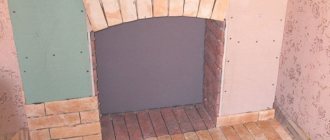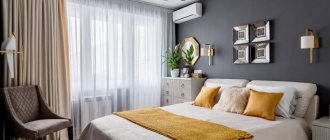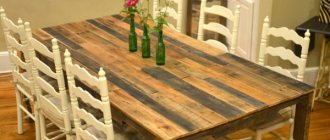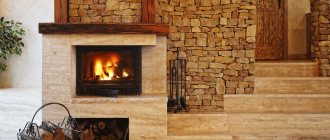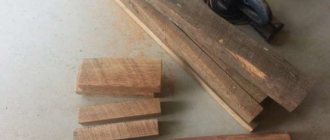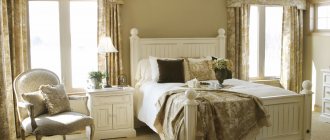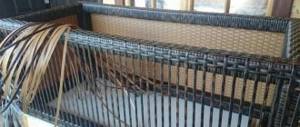Gas fireplaces are increasingly among the most popular heat sources, because they perform not so much a decorative role as a full-fledged functional task, even in comparison with more classic wood-burning fireplaces. If we discard decorative elements, then a gas fireplace can even be used as the main source of heat. Energy consumption is quite acceptable, plus, the same temperature is constantly maintained. For example, for an average house in a village, the area of which is 50 square meters. The power of the unit should vary between 3-8 kW. Moreover, take into account the fact that the efficiency of such devices is more than 80%.
Gas fireplace installation
A gas fireplace using bottled gas or any other consists of special compartments. For example, the firebox is considered the main and main element; it can be of completely different configurations and shapes. Open, closed, combined mode and others. In this way, a wide variety of design ideas can be created. The body is often made of durable heat-resistant steel; a burner and a reflector are placed inside - also known as a screen. All structural parts are covered with special panels that seem to imitate natural wood. The panels are made from heat-resistant materials such as ceramics. They prefer to make the front side where the door is made of glass so that they can enjoy the flame.
Installation of liquefied gas cylinder
The process of removing gases occurs using a chimney, which, by the way, also plays the role of fresh air ventilation. Take into account an important point when constructing channels, pay attention to the formation of draft, especially in closed chambers.
As for the decor and cladding, great importance is attached to these details. When forming a “portal”, you need to use only durable materials, for example, the recently popular heat-resistant plasterboard, porcelain stoneware, and natural stone. The “portal” must provide an exit from the furnace from the heated air. By the way, automation is no stranger to fireplaces; as a rule, such systems are sold as a set and allow you to remotely and automatically regulate the temperature.
Heating organization
- The first step is to allocate a separate room where the propane tank will be located. It should be located as far as possible from other living rooms, and also have good ventilation.
- If the power of the gas fireplace exceeds three kW/h, then it is necessary to install a cast iron and steel pipe (for the chimney). Cover its outer part with a mineral insulator and cover it with a cover.
- If the structure has a lower power, then in this case the combustion products are disposed of using the installed supply and exhaust ventilation.
- Also a prerequisite, if the room has a fireplace, is the installation of an alarm system and sensors for incomplete combustion of gas. If you have a fireplace model with a closed chamber, then you do not need to install sensors and a chimney. However, in this case you will need a fan for blowing the chamber and electricity to operate the automation.
If you can still complete the previous steps yourself, then in order to connect the fireplace, you cannot do without the help of a specialist. To do this, you can contact the gas service or the foreman of the organization from which you purchased the equipment.
Advantages and disadvantages
A gas fireplace for your home has a certain list of positive aspects, such as:
- Much more environmentally friendly, cleaner than wood-burning stoves, because much less harmful fumes and resins enter the air.
- Structurally, gas appliances are simpler, and the price characteristics are advantageous in this regard.
- Possibility to enjoy the flame, as in wood-burning structures.
- High performance, up to 8 kW.
- Quite easy to maintain, does not require frequent cleaning and maintenance, and does not require constant monitoring.
As for the disadvantages, there are certainly some caveats, such as:
- To install a gas fireplace in an apartment or for a country house, you will need a special permit;
- installation is permitted only by a certified specialist;
- Natural or propane gas is used as fuel, therefore, if operating rules are not followed and the system is violated, such units can cause serious trouble.
Varieties
Without chimney
The gas fireplace is a frequent guest in the apartment. They do not build a chimney out of brick, but remove vapors that are unpleasant to the lungs through a chimney pipe with a layer of insulation from the inside against the formation of condensation. Models without a chimney are classified by thermal power, but an efficiency of 85% unites them.
Infrared
A popular heater is a gas infrared fireplace. It runs on propane-butane gas. In the store they buy a gas fireplace, and in addition to it an infrared burner. The room temperature is maintained by direct heating and infrared radiation. Ceramic panels are a mandatory heating element, and the heat is directed not at heating the room, but at the person.
On bottled gas
Gas fireplaces operate on liquefied gas from cylinders or natural gas from a gas pipeline. To distinguish between models, markings are used: N for main gas and P for bottled gas. There was no provision for the interchangeability of one burner with another.
Stove-fireplace
A gas-powered fireplace stove attracts bathhouse owners. Bathing procedures are so close in spirit to Russian people that the construction of a dacha is not complete without the construction of a bathhouse.
This sauna stove is either inflatable or atmospheric. Inflatable - automated with air supply using a fan, and atmospheric - non-automated, operating without the intervention of electric current. Both burners are economical and equally safe.
Convector fireplace
A convector fireplace running on gas heats the dacha, which the owners visit twice a week, in an hour and a half. It works without laying communication systems - they do not install a boiler room, circulation pump, connecting links, supports, etc.
Street
When making gas outdoor fireplaces, natural stone or concrete is used. They take the shape and size desired by the owner. When choosing, it is easy to be guided by the landscape style created on the site.
Fireplace table
The Napoleon company produces the Patioflame fireplace table as an original addition to the seating area in a VIP restaurant. There is a place for it on the terrace of a penthouse or house outside the city. A tabletop fireplace provides the basis for experimenting with the environment.
Trilateral
This fireplace has a combustion area closed on 3 sides by a U-shaped window made of glass ceramics. The firebox was positioned so that it does not interfere with observing the fire. It is mounted in a false wall, which divides the living space into zones. This method is not the only one. If desired, install a three-sided fireplace in the center of the room or lean it against one wall.
With heat exchanger
When heating a country house, fireplaces with a heat exchanger are rarely used. The reason is limitation in application. There is no constant supply of fuel, and therefore the owners get very cold at night.
Principle of operation
As for the principle of operation, a gas fireplace, regardless of whether it is for a dacha or an apartment, has the same operating procedure. Through a special pipeline, gas is supplied to the firebox, where air is also delivered; as a rule, fireboxes are closed for safety. Combustion or complete combustion is regulated by special sensors or in a random order, according to the same principle as classic gas stoves for cooking. The principle of gas removal is similar and not fundamentally different from wood or gas boilers.
Scheme of work
The most complex element of the system, as many thought, is not the chimney, but the burner itself. A gas burner for a fireplace with your own hands can only be created if all the rules and features are combined, otherwise they will not be able to arrange it for you. Therefore, think in advance, perhaps it will be cheaper and more reliable to buy a ready-made burner and not “be tricky” with making it yourself.
Decorating the fuel device
The fireplace burner can be decorated with additional elements. This will not only improve the design, but will also help disguise the wick.
Among the most popular decorations are:
- Ceramic logs , the size of which must match the dimensions of the hearth. Such elements will imitate a fire.
- Various types of natural and artificial stones , which can be the same or different sizes, transparent or colored, smooth or with a textured surface. Pebbles can be laid out not only on the grate, but also outside it.
- Stylized surrounding objects : poker, tongs, tools for lighting and extinguishing. Here you can also put fuel in decorative packaging.
Also good are decorative cladding made of heat-resistant ceramics, and clay and faience figurines that can be placed on the fireplace lid or next to it.
It is advisable to use removable decorative components, which will allow you to periodically change the appearance of the device.
Firebox shapes
A gas fireplace is chosen not only for its performance; the shape of the firebox also has a significant impact. Moreover, it plays a role on what kind of heating equipment the fireplace uses, stationary or balloon method. There are several main types of fireboxes based on location:
- “Front” for placement against walls. (classic method).
- Corner types, for installation in corners.
- “Island types” are designed to be placed in the center of a room, around a specific location. (They have visibility from any side).
- Double sided. I use them for installation in two rooms at once, because the firebox is visible from both sides. As a rule, only minor class partitions are suitable for this purpose.
Front fireplace
When choosing, consider not only your aesthetic preference, but also the very possibility of connecting communications to the chosen location. For example, for suburban buildings, the supply can be made in any condition, even through a wall or ceiling. But apartment fireplaces are somewhat problematic; in such cases, the choice falls on only two main types of placement: corner and front. Moreover, they should be located near the external walls through which the pipe will be “installed”.
Operating principle and design of the biofireplace
Bio-fireplace (eco-fireplace) is a type of fireplace that is heated with liquid biological fuel. When such substances are burned, no smoke or soot is released, so a chimney is not needed for the operation of such a device.
At the same time, the room where the bio-fireplace is located must be periodically ventilated, since any combustion consumes oxygen.
We discussed in more detail the principle of operation of a biofuel fireplace in the next article.
Classification by installation method
Such heating devices differ not so much in their design as in their dimensions and location in the apartment. According to the above criteria, three types of eco-fireplaces can be distinguished.
Variety #1 – tabletop
Tabletops are small products that come in a variety of shapes and designs. For fire safety, such structures are provided with a dense fire-resistant glass screen that hides the flame.
Variety #2 – wall-mounted
Wall-mounted devices, which can be up to 1 meter in length, are usually made of metal and glass. Such models are not only decorative, but also functional. They heat the room, especially if there are several burners installed in the fireplace.
Variety #3 – floor-mounted
Eco-fireplaces, which have large dimensions, are installed on the floor, often in niches or corners of the room. There are floor-standing models, complemented by support legs that allow you to adjust the height of the structure, or wheels, thanks to which the device can be moved around the house.
Like wall-mounted biofireplaces, floor-mounted options combine a decorative role with a functional one, filling the room with warmth.
Advantages and disadvantages of biofireplaces
Like any device, such lesions have strengths and weaknesses.
Regardless of the model, all eco-fireplaces have the following advantages:
- Simplicity of the device . Equipping the fireplace does not require laying ventilation ducts, installing a chimney, or agreeing with neighbors.
- Mobility . Biofireplaces are usually quite lightweight devices. Many options are specifically designed for their movement indoors.
- Ease of operation . Using such devices is extremely easy. It is only important to purchase biofuel and refuel the fireplace on time.
- Safety . When burning, soot, carbon monoxide, smoke and other harmful substances are not released, and many models have a dense screen that prevents open fire.
- Air humidification . When bioethanol burns, carbon dioxide and water vapor are formed, which improve the indoor microclimate.
At the same time, a number of problems associated with the operation of eco-fireplaces should be noted.
Negative factors include:
- Low heat dissipation . When biofuel burns, a small amount of heat is released.
- High cost of bioethanol . Liquid biofuel is more expensive than traditional fuel options.
- Need for ventilation . Since when a fire burns, the oxygen level in the room where the eco-fireplace is located decreases, it is advisable to arrange additional ventilation in it or take care of frequent ventilation of the room.
The negative aspects of biofoci can be neglected, especially when it comes to decorative devices.
Main design elements
With all the variety of eco-fireplace models, their design consists of similar elements, namely:
- Heating block . The main component of the biofocus, where the fuel is located. There are two options for such a device: a burner and a tank, which we will discuss below.
- Housings _ This detail determines the design of the product. Depending on the project, the body can be open or closed, have the shape of various geometric shapes, or be styled as a shelf, candelabra, or coffee table.
- Decorative components . To decorate eco-fireplaces, decor made from heat-resistant materials is often used: stones, metal, fire-resistant ceramics.
You can make all these parts yourself by building a bio-fireplace with your own hands.
Biofireplaces can use two types of heating devices: a fuel tank and a burner.
Fuel tank , the volume of which ranges from 60 ml to 5 liters, is usually used in factory models of biofireplaces.
As a rule, tanks are made of durable metal, most often stainless steel. It is very important that the walls and bottom of the device are of sufficient thickness: this guarantees safety and long service life.
Fuel tanks have significant advantages:
- Their design guarantees absolute tightness of the container, so dust and foreign bodies do not get inside.
- When using such models, the smell of bioethanol is completely absent in the room, since liquid fuel and its vapors are retained in the tank.
- The design of fuel tanks provides special devices for regulating the intensity of fire. This is especially important if the fireplace is built into the wall or its surface is decorated with accessories made from materials that are not particularly fire-resistant.
- Such devices also provide the ability to quickly and easily extinguish fire. To do this, just turn the lever, which shuts off the flow of biofuel.
The disadvantage of such models is the rather high price.
A simpler version of the heating unit is an eco-fireplace burner . Externally, such a device looks extremely simple: it is a tank designed for pouring bioethanol, which can have different shapes.
Using such devices is not as convenient as a fuel boiler. The burners also do not have a mechanism for regulating the intensity of the fire, as well as the ability to quickly extinguish a flared flame
There are special devices for extinguishing that need to be purchased additionally; in addition, when they are used, a pungent odor is felt in the room.
At the same time, biofireplace burners also have their advantages. Such devices are low in price, and their simple design allows you to make them yourself. In addition, several such devices can be installed in one fireplace at once, which will significantly increase heat transfer.
Choosing a place to install a fireplace
A gas fireplace for your dacha can be placed subject to the rules and regulations for the operation of such units. The most important point when installing systems is the ability to connect to a ready-made chimney without significant problems. For example, for apartments, as already mentioned, installation is carried out near external walls. For suburban buildings, it is realistic to offer a full-fledged vertical chimney. At the same time, do not forget that special attention should be paid to the thermal insulation of floors. Often, two-section sandwich pipes are used for houses.
Other requirements for installing fireplaces include special placement rules; they should not be placed near flammable materials such as furniture. In addition, a mandatory requirement is the lining of the fireplace walls, because during operation they get quite hot. As mentioned above, in addition to the lining, it is also necessary to provide additional ventilation outlets so that the air that accumulates between the lining and the fireplace wall escapes into the room.
Is a gas fireplace for a summer house a worthy choice, or not?
A fireplace installed in a country house not only gives a special atmosphere, but can significantly warm the room. Particularly popular are gas fireplaces with automatic or semi-automatic fireboxes, which can be connected both to the main gas pipeline and to operate from bottled gas. This mobility of connection ensures that the fireplace can be installed anywhere in a country house.
What should you consider during installation?
When installing in apartments, you need to remember that laying it in walls and on the floor is prohibited. In addition, for an apartment, special requirements are attached to sealing all seams. In addition, remember that gas fireplaces for summer cottages are not recommended to be located near drafts. Also pay attention to such points as the presence of furniture near the fireplace; all flammable design elements and others must be removed to a safe distance. Especially when it comes to fireplaces with an open firebox.
By the way, when installing gas fireplaces, you should remember that they are more susceptible to the release of moisture and carbon dioxide. Therefore, the chimney shaft must meet all conditions for the release of aggressive substances. It is better to use multi-circuit stainless pipes with the necessary layer of thermal insulation.
What will influence the choice
The choice has to be made in any case, but in order not to waste your own strength and that of the seller, you can prepare in advance the characteristics of the model you need. A simple plan will help you create these characteristics.
Dummies of firewood in the firebox are almost like real ones
Despite the similarity in structure and operating principle, fireboxes designed for different types of gas are not interchangeable. Decide in advance which type of gas is most convenient for you to use. It is easy to recognize the types of fireplaces by fuel type by special symbols on the device code. Fireboxes designed for natural gas are marked with the letter “N”, and for a propane-butane mixture – “P”.
Remember that a fireplace has two functions. To create the appearance and style of a room, you can not pay attention to the technical characteristics of the device. But if you are purchasing a gas fireplace, which should work like a real heater, then you will have to take other parameters into account.
The main indicator of a fireplace’s performance is its power. Calculation of the heated area is mathematical in nature and is quite difficult for the buyer. It is recommended to evaluate the capabilities of the selected fireplace based on the fact that to fully heat 10 m2 of room area, 1 kW of power is required. After measuring and calculating the area, it is not difficult to obtain the recommended indicator.
Having decided on the parameters, you can begin to select the location for further installation. Depending on the mounting method and location of the fireplace, there are different models.
Built-in fireplace system option
- Wall-mounted fireplaces are a reflection of modernity. In addition, this is a great option to save the fireplace from pets or small children. These types of models are light enough to hang on the wall.
- Floor-standing fireplaces have a ready-made body and do not require additional modification. They can be used immediately after connection by a specialist (in the case of using mains gas) or independently (in the case of using bottled gas). The exact orientation at the installation site is affected only by the convenience of installing the gas pipeline.
- The classic look is reminiscent of built-in fireplaces framed by a portal. This portal can be completed independently or purchased together with the firebox. The outdoor version of a fireplace without a chimney deserves special consideration, since it is built entirely by the residents of the house with their own hands. This option is also called open.
It is impossible not to say about the subtypes of the above classification. These are wall, corner and island fireplaces. Wall-mounted ones are mounted against the wall of the room and have an external or built-in chimney. The outer one is closed from above with a casing and lined with brick. But gas fireplaces for a country house should save space, so corner models are often used. They fit so harmoniously into the corner that, with skillful selection of facing materials, they do not take away volume from the room.
The efficiency and service life are affected by the material from which the firebox itself is made. Steel is quite unstable to temperature changes and can “burn out” over time; moreover, its ability to remove heat is much worse than that of the cast iron variation.
Double-sided fireplace system
The disadvantage of a fireplace with a cast iron firebox is its weight. But it does not exceed the average maximum load for various floors. This means that any gas fireplace can be installed without a foundation, on a horizontal surface prepared in advance.
Gas fireplace installation procedure
Gas fireplaces for heating require no less attention than a conventional stove or boiler. It is necessary to take into account a certain operating procedure, including:
- Preparing the space. Pipes (gas, chimney) are supplied. If the fireplace operates on liquefied gas, you need to prepare a site for installing the cylinder.
- The load on the “cushion” is calculated, take into account the average values, which is no more than 800 kg per meter. The floor is leveled and covered with a non-flammable coating, and the same work is done with the wall.
- The firebox is being installed; for subsequent connection, you need to call the gas workers.
- The firebox is connected, after which the draft in the supplied chimney is checked. If the draft is not enough, you need to lengthen the channel, or buy a forced fan.
- Proceed with cladding and installation of the “screen”. You can use any fire-resistant material, including drywall. But remember, about the installation features, you need a special sheathing.
- If necessary, automation is connected.
Device and functions
Natural gas and bottled gas fireplaces have the same structure and differ only in the diameter of the nozzle on the burner. The firebox contains a heat exchanger with an increased area due to the design of the fins. The burnt gas enters the smoke collector - a special conical casing designed to prevent combustion products from scattering and entering the room. The chimney is a continuation of the smoke collector.
Wall-mounted fireplace variation for an apartment
Gas is supplied to the furnace using a burner, which is a pipe with nozzles. Located in the lower part, it is practically invisible to the observer. Some models provide for masking the burner with fake logs. This dummy is made of ceramic and does not burn from flame.
If the fireplace model is closed, the firebox is protected by special fire-resistant glass. Through it you can calmly admire the living flame. The automation system or controller is located in the cold zone. It serves to process signals coming from sensors and provides feedback by regulating the gas supply.
Fireplaces using liquefied gas are equipped with a compartment in which the cylinder is placed. You can easily install such a cylinder in the fireplace body under the firebox itself. Its capacity depends on the specific model.
When you turn on the fireplace by pressing a button or turning a knob (it all depends on the model of the control panel), feeding begins. Then, using the piezoelectric effect, a spark is created that ignites the gas. The fireplace has started and will begin heating to the set range.
Building a through fireplace
- Nice bonuses:
- Free delivery within Moscow for orders over RUR 50,000.
- Fireplace project as a gift when paying for equipment.
- Accessory as a gift when purchasing FirePlace stoves.
- Refund of payment for an engineer's visit upon concluding an installation contract.
At the next project, the task was to build a through fireplace in a wooden house, as well as install a Schiedel UNI ceramic chimney and line the top with brick. It would seem like a standard job, but there were some surprises here, which we will discuss below.
So, let's start in order. First of all, we install the chimney. There was nothing difficult for our craftsmen here, the work was familiar, but it required physical effort, because in houses with second light, lifting heavy blocks to a height is not an easy job and it is impossible to do without installing scaffolding. The customer purchased all the equipment and materials independently from third-party organizations, so the chimney ended up with a 90-degree tee, although a 45-degree tee would have been preferable for a fireplace, but this does not greatly affect the operation of the firebox, so we established what it was.
In this case, the fireplace lining is installed to the chimney, so we expand the structure using a profile frame and cover it with GVL. The house is wooden, so it is necessary to leave a gap under the ceiling and roof for shrinkage. At one end of the box we leave a niche for the cleaning tee and the condensate collection grid. The niche can be closed with a hatch if desired.
The chimney is installed and the fireplace can now be assembled. There was a surprise here. The lining and firebox were purchased by the customer from Meta. The kit did not include a stand for the firebox, so we decided to install it on brick columns.
The second unpleasant moment was the poor quality of the Meta cladding, namely the geometry of the parts. Almost all the parts had to be filed and polished. A day and a half was spent on this work. As a result, the customer had to spend the amount saved on cladding to pay for this work.
Tunnel fireplace inserts
0%
Horizont "O" 1xVD 740/570 Standart fireplace insert Kobok
RUB 303,263 RUB 303,263
Availability
- To order
On request Add to cart
0%
Horizont "O" 2xVD 1270/570 Standart fireplace insert Kobok
RUB 553,928 RUB 553,928
Availability
- To order
On request Add to cart
0%
Vertical VD O 670×900 Standard fireplace insert Kobok
RUB 348,359 RUB 348,359
Availability
- To order
On request Add to cart
0%
Horizont "O" 1xVD 850/570 Standart fireplace insert Kobok
RUB 331,660 RUB 331,660
Availability
- To order
On request Add to cart
0%
Horizont "O" 1xVD 1170/570 Standart fireplace insert Kobok
RUB 505,438 RUB 505,438
Availability
- To order
On request Add to cart
0%
Horizont "O" 1xVD 970/570 Standart fireplace insert Kobok
RUB 360,147 RUB 360,147
Availability
- To order
On request Add to cart
0%
Fireplace CARBEL RK-100 DS (Spain) (Spain)
Availability
- To order
On request Add to cart
0%
Horizont "O" 2xVD (width 1570 mm) Kobok fireplace insert
Availability
- To order
On request Add to cart
0%
Horizont "O" 2xVD 1370/570 Standart fireplace insert Kobok
RUB 595,720 RUB 595,720
Availability
- To order
On request Add to cart
The Shidel company offers several options for lining the chimney above the roof; at this site the task was to install a load-bearing cantilever slab and line the chimney with facing bricks. I would like to say right away that this work is quite labor-intensive, which is why the cost of installing the chimney is higher. According to Shidel pipe technology, it is necessary to secure it under the roof. In our case, original fasteners were used to secure the chimney to the wall.
The fireplace is installed and put into operation.
We are in touch Call back Chat
design, production, installation of fireplaces
